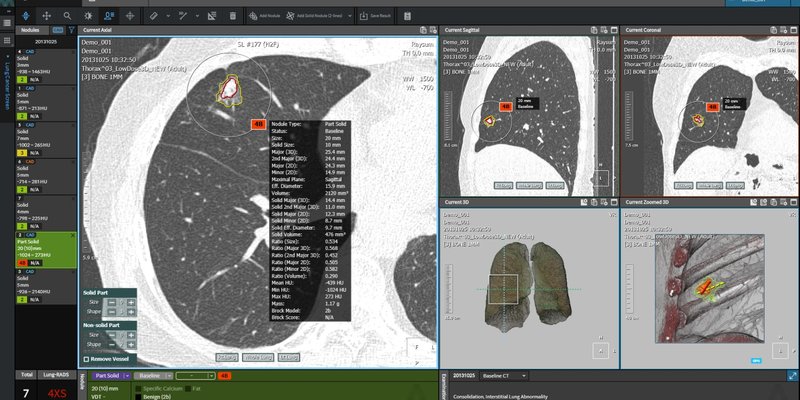
A retrospective study in Belgium assessed AVIEW LCS+ (Coreline Soft), an AI tool designed for lung nodule detection/classification/volumetry, using CT scans of an anthropomorphic phantom embedded with 18 nodules varying in diameter and morphology. The primary aim was to validate the tool's accuracy in detecting and measuring lung nodules across varied imaging conditions. The performance was benchmarked against a precise ground truth established through µCT scanning.
The AI tool consistently demonstrated high detection sensitivity (minimum 83%) and precision (up to 91%), with little variation across a range of testing conditions, including different radiation doses (0.20 mGy to 6.04 mGy) and reconstruction algorithms (iterative and deep learning). Notably, volumetric measurements for nodules larger than 6 mm were accurate within a 10% range of the ground truth, irrespective of the imaging parameters, underscoring the tool's reliability in diverse operational settings.
Read full study
Absolute ground truth-based validation of computer-aided nodule detection and volumetry in low-dose CT imaging
European Journal of Medical Physics, 2024
Abstract
Purpose: To validate the performance of computer-aided detection (CAD) and volumetry software using an anthropomorphic phantom with a ground truth (GT) set of 3D-printed nodules.
Methods: The Kyoto Kaguku Lungman phantom, containing 3D-printed solid nodules including six diameters (4 to 9 mm) and three morphologies (smooth, lobulated, spiculated), was scanned at varying CTDIvol levels (6.04, 1.54 and 0.20 mGy). Combinations of reconstruction algorithms (iterative and deep learning image reconstruction) and kernels (soft and hard) were applied. Detection, volumetry and density results recorded by a commercially available AI-based algorithm (AVIEW LCS + ) were compared to the absolute GT, which was determined through µCT scanning at 50 µm resolution. The associations between image acquisition parameters or nodule characteristics and accuracy of nodule detection and characterization were analyzed with chi square tests and multiple linear regression.
Results: High levels of detection sensitivity and precision (minimal 83 % and 91 % respectively) were observed across all acquisitions. Neither reconstruction algorithm nor radiation dose showed significant associations with detection. Nodule diameter however showed a highly significant association with detection (p < 0.0001). Volumetric measurements for nodules > 6 mm were accurate within 10 % absolute range from volumeGT, regardless of dose and reconstruction. Nodule diameter and morphology are major determinants of volumetric accuracy (p < 0.001). Density assignment was not significantly influenced by any parameters.
Conclusions: Our study confirms the software’s accurate performance in nodule volumetry, detection and density characterization with robustness for variations in CT imaging protocols. This study suggests the incorporation of similar phantom setups in quality assurance of CAD tools.